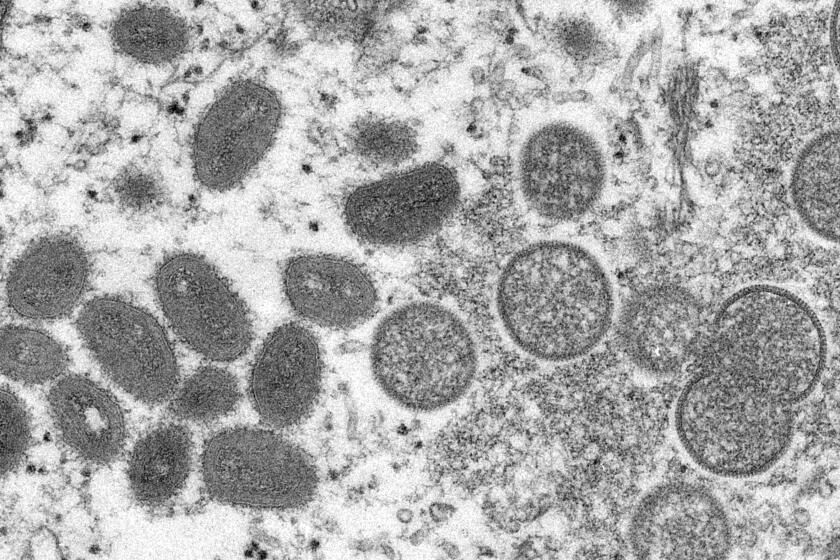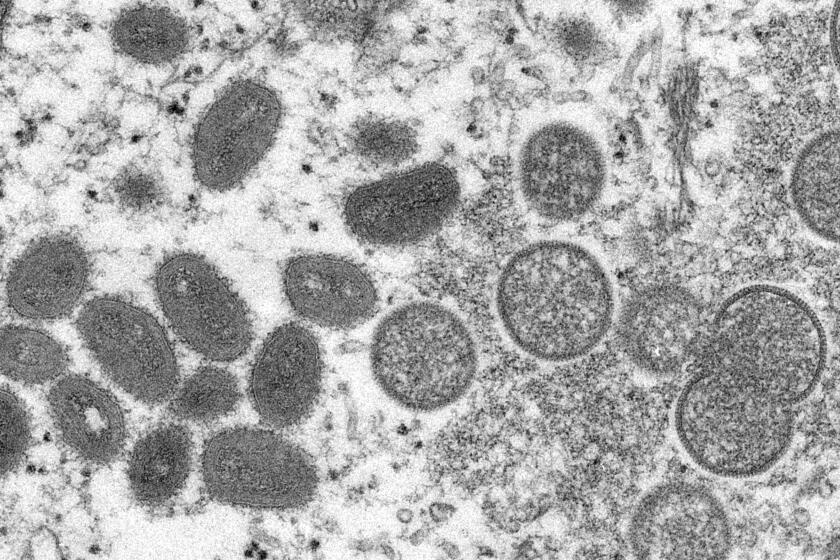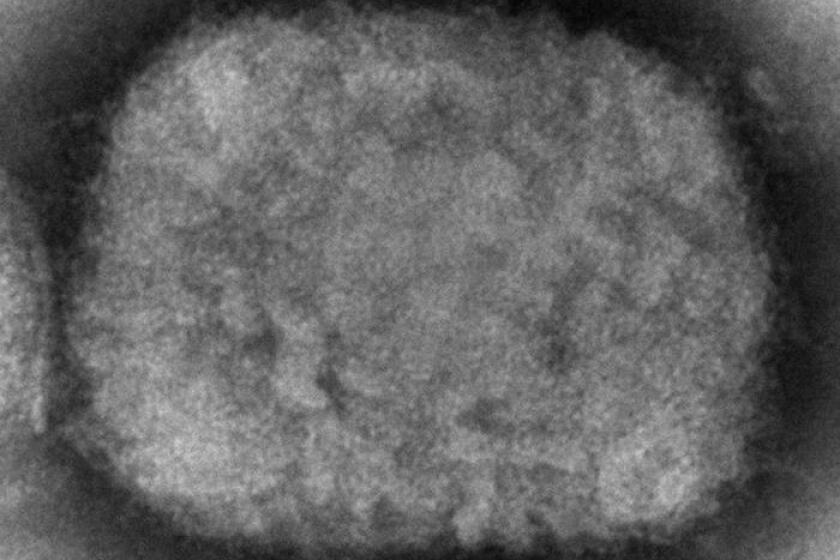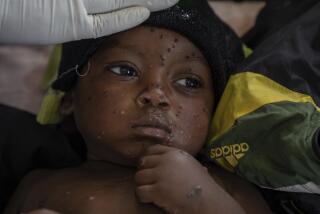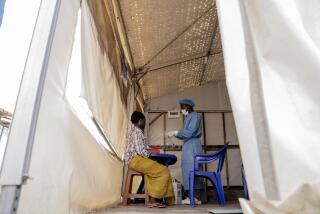Sex, rashes and outbreaks: A rational guide to the monkeypox risk in California
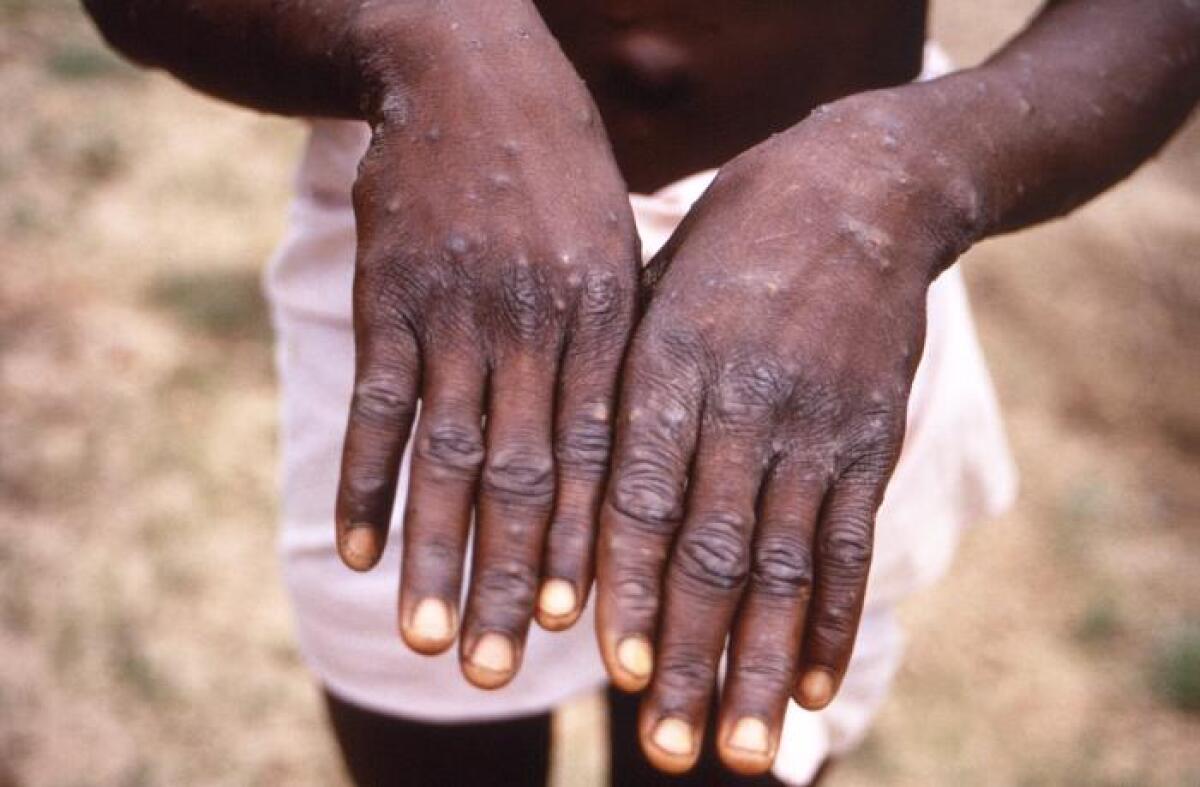
California marked its first suspected case of monkeypox Tuesday, in a person in Sacramento County.
The person, who recently traveled to Europe, is isolating at home and isn’t in contact with other people, health officials said Tuesday.
With case counts in the U.S. relatively low, why are officials paying close attention to this outbreak? And why are they less concerned about monkeypox than about COVID-19?
“We’re concerned enough about the pace at which new cases are developing worldwide that we want to raise everyone’s attention to be very vigilant, so we can try and control this as quickly as possible,” Dr. John Brooks, an epidemiologist for the U.S. Centers for Disease Control and Prevention’s Division of HIV/AIDS Prevention, said during a briefing.
Here’s what we know:
Why are we hearing about monkeypox now?
Besides the one suspected case in Sacramento County, there has been at least one confirmed case of monkeypox in Massachusetts and four other presumptive cases, two in Utah, one in New York City and one in Florida, the CDC said Monday. All five involved men who had recently traveled internationally.
The U.S. cases come on the heels of clusters of monkeypox infections in Europe — most notably in Portugal, Spain, Britain and Belgium. British authorities have confirmed more than 70 cases of monkeypox in the last 2½ weeks. Fifteen cases have also been reported in Canada.
A person with a suspected case of monkeypox is isolating at home in Sacramento County, health officials say.
During the past five years, there has been a resurgence of monkeypox in Nigeria, Africa’s most populous nation, Capt. Jennifer McQuiston, the CDC’s deputy director of the Division of High Consequence Pathogens and Pathology, told reporters in a briefing Monday.
“What’s different about what we’ve been seeing around the world in the past two weeks is that most cases do not have recent travel to Nigeria, or to another country where monkeypox would normally be found,” she said. “Some have traveled to other countries in Europe and Canada, in late April and early May. And we’re actively working to try to connect these dots to identify how the cases are spreading between countries.”
A person with a suspected case of monkeypox is isolating at home in Sacramento County, health officials say.
What are the demographics of those infected?
Officials emphasize that monkeypox can affect anyone, including healthcare workers and family members caring for those sick with the illness.
Many of the people infected in the current global outbreak identify as gay or bisexual, Brooks said. While one World Health Organization expert suggested in an interview with the Associated Press that the recent spread may have been associated with sexual behavior at two raves in Spain and Belgium, some cases may have preceded those events.
Some of those believed to have monkeypox in the U.S. had traveled at the end of April and showed their first symptoms in early May, “so that precedes some of the festivals I think that you’re referencing that happens in mid-May in Europe,” McQuiston said in response to a reporter’s question.
“It suggests it’s been circulating for a couple of weeks, perhaps a couple of months or longer. But I think we’re still in the early phase of the investigation. And hopefully as we get more information from cases, we’ll be able to piece together a more complete picture,” she said.
An expert describes the unprecedented outbreak of monkeypox in developed countries as ‘a random event’ possibly sparked by risky sexual behavior.
How can you get infected with monkeypox?
Monkeypox is nowhere near as contagious as COVID-19 or other respiratory illnesses. Among humans, it can be transmitted through sustained skin-to-skin contact with someone who has an active rash, McQuiston said.
It’s also plausible that it can be transmitted through respiratory droplets among those with lesions in their mouth and throat who are around another person for an extended period of time. But spread of monkeypox through the air is not thought to be a major source of transmission.
Investigations of people who flew on long airplane flights while potentially infectious showed no spread among passengers, according to McQuiston. That means that people passing by an infected patient at a grocery store will not be at risk for contracting monkeypox, she added.
The virus can be spread during sexual and intimate contact and shared bedding and clothing as well as through monkeypox sores.
Monkeypox is garnering increased attention because outbreaks and cases are showing up in areas where they don’t usually occur.
With Pride coming up, are officials urging events be canceled?
No. There’s not sufficient evidence of the sort of monkeypox spread that would warrant events being canceled or postponed, the CDC’s Brooks said.
“On the contrary, what we want to do is empower people to take the initiative to hold themselves back from participating if they’re feeling ill,” Brooks said.
People who feel ill or have a fever or unusual skin rashes or lesions should stay home and get checked out.
“This is a virus that could affect anyone. If you’re a man who has sex with men, you’re going to be going out and gathering with other men ... be cognizant of the fact that if you’re feeling ill and you have a rash, it might be a good time to step back,” Brooks said.
Someone should also seek medical evaluation if they develop symptoms or a suspicious rash following an event, he added.
Monkeypox is garnering increased attention because outbreaks and cases are showing up in areas where they don’t usually occur.
Where are the monkeypox skin rashes or lesions being found?
Typically, the rash starts on the face and then spreads to other parts of the body, turning into pus-filled sores before they fall off.
But in some cases in the current outbreak, during the early stages of illness, the rash has been mostly in the genital area and in or around the anus, Brooks said.
“In some cases, it has produced anal or genital lesions that look like other diseases, like herpes, chickenpox or syphilis,” Brooks said.
What comes first, the fever or the rash?
Traditionally, monkeypox is believed to begin with a fever and feeling of being unwell, followed by a rash. But in some cases, the rash has appeared first, McQuiston said. The symptoms reported in the current cluster of cases appear to be mild.
“Anytime there’s a rash present, a person should be considered potentially infectious,” she said.
Other symptoms can include headache, muscle aches, backache, chills, exhaustion and swollen lymph nodes. Rare complications include lesions that appear in the eye, which can endanger vision.
Officials are concerned about the possibility of severe disease in certain populations, such as the immunocompromised or those with skin conditions, such as eczema. But antiviral drugs are available for people at higher risk for severe disease or have severe disease already.
People who have HIV and are doing well on their treatment course probably aren’t at risk for severe disease from monkeypox, Brooks said. But a study more than a decade ago that looked at a small number of patients with a severely weakened immune system showed they suffered more prolonged monkeypox illness, developed larger skin lesions, and it took a longer time to stop producing the virus.
“It’s another reason why, if you’re a person who may be at risk due to a weakened immune system, to be particularly careful about seeking out early care and evaluation,” Brooks said.
U.S. and European health officials identify a number of cases of monkeypox, an illness previously limited mostly to central and western Africa.
Can people spread monkeypox while showing no symptoms?
People are considered potentially infectious while they’re ill with a fever or some kind of skin rash or lesion.
It’s also plausible that a person could be contagious without such outward symptoms if a lesion is in their throat or mouth.
“Those lesions could potentially be infectious, even though you don’t have a visible rash on your body, but it really is the lesion that is the source of virus,” McQuiston said.
Overall, though, the most infectious aspect of monkeypox is the lesions on the skin, according to Brooks.
What should people who get monkeypox do?
The best advice is to stay isolated so the illness isn’t spread to close family members, McQuiston said. Close contacts should be notified so they can be on the lookout for symptoms.
“Most patients with monkeypox will recover on their own within two to four weeks of their first symptoms,” McQuiston said.
If patients suspect they have monkeypox, Brooks said they shouldn’t “hesitate to advocate for your health and inform your doctor of your concerns if you think you might have been exposed.”
Massachusetts has reported a case of monkeypox in a man who recently traveled to Canada.
Where did monkeypox come from?
Monkeypox emerged as humanity was on the path to eradicating its cousin, smallpox.
First discovered in 1958 in colonies of monkeys kept for scientific research, monkeypox is typically found in rodents and primates in central and western Africa, the CDC said. The first human case was documented in the Democratic Republic of Congo in 1970.
There are two strains of monkeypox. The strain identified in the current outbreak is the West African strain, which is the milder of the two, McQuiston said.
Has monkeypox been found outside of Africa before?
Yes, in a number of countries.
The only previous U.S. outbreak occurred in 2003, leading to 71 confirmed or suspected cases — mostly in Wisconsin, Indiana and Illinois. Those who were infected had come in contact with pet prairie dogs obtained from an animal distributor in suburban Chicago that had been housed near Gambian giant rats and dormice that came from Ghana.
The recent resurgence of monkeypox in Nigeria has also led to nine documented cases among travelers returning to their home countries after visiting the nation.
According to the World Health Organization, historically, between 0% and 11% of those with monkeypox have died from the disease, with the fatality rate higher among children.
While monkeypox can be fatal in countries where healthcare resources are poor, the 2003 U.S. outbreak did not lead to any deaths.
Health officials in Spain have reported seven cases of monkeypox, and Portugal updated its number of confirmed cases to 14.
Are vaccines available?
There is one vaccine that is licensed to prevent monkeypox and smallpox. It’s called Jynneos and was approved in 2019 by the Food and Drug Administration to prevent both diseases in adults determined to be at high risk for infection.
There are about 1,000 doses available. It’s designed as a two-dose vaccine, “and we expect that level to ramp up very quickly in the coming weeks as the company provides more doses to us,” McQuiston said.
An older vaccine, ACAM2000, licensed for use in the U.S. to prevent smallpox, can also be used against monkeypox. That’s the version recommended for military personnel and laboratory scientists who work with the class of viruses that includes smallpox and monkeypox, which are collectively known as orthopoxviruses.
There are 100 million doses of ACAM2000 available. But there are downsides, with some potential significant side effects, McQuiston said.
She said officials are hoping to maximize vaccine distribution to those they know would benefit from it, such as people who have had close contact with a known monkeypox patient, healthcare workers and those at high risk for severe disease.
How long does it take for officials to confirm a suspected monkeypox case?
It typically takes a couple of days between the time a patient comes to a physician’s attention and the time a test result suggests a virus sample is monkeypox.
State labs are able to rapidly conduct a preliminary test that can determine whether a virus is an orthopoxvirus. Confirmatory testing is then done at the CDC to determine what kind of orthopoxvirus it is, McQuiston said.
Are dogs and cats at risk of getting monkeypox?
McQuiston said she doesn’t think monkeypox poses a high risk to pets. During the 2003 U.S. monkeypox outbreak, “we did not see spread during that outbreak, for example, to domestic pets,” she said.
Where did this strain of monkeypox come from?
All the evidence thus far “suggests that the monkeypox virus that is circulating ... is closely related to the monkeypox viruses that we’ve seen circulating in West Africa over the last several years,” McQuiston said.
The CDC has analyzed the strain from the confirmed case in Massachusetts, and it’s very closely linked to the monkeypox viruses that have been circulating out of West Africa recently.
“All signs point to this being an outbreak associated with person-to-person spread,” McQuiston said.
More to Read
Sign up for Essential California
The most important California stories and recommendations in your inbox every morning.
You may occasionally receive promotional content from the Los Angeles Times.
